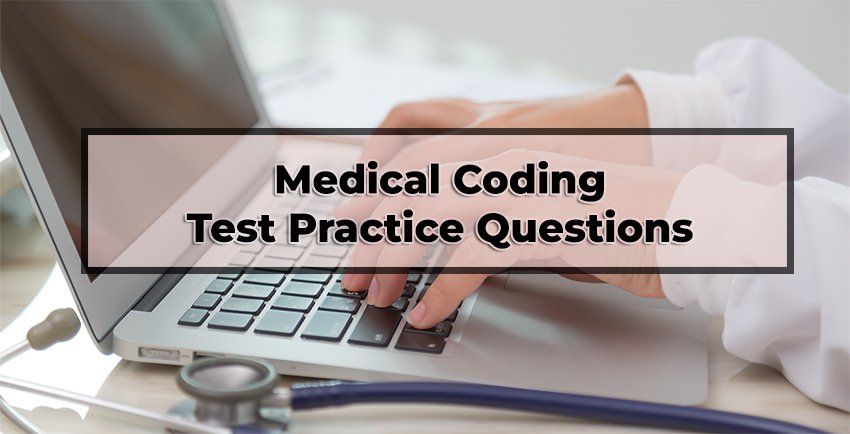Medical Coding Test Practice Questions
Preparing for a medical coding exam requires more than just studying guidelines and coding manuals—it also involves practicing with real test questions to get a feel for the exam format and the types of coding scenarios you’ll face. Here are some practice questions designed to help you gauge your understanding of medical coding systems such as ICD-10-CM, CPT, and HCPCS Level II, along with coding principles applied in both inpatient and outpatient settings.

Practice Questions:
1. Question: A 35-year-old patient is diagnosed with type 2 diabetes mellitus with diabetic neuropathy. Which of the following ICD-10-CM codes is correct?
- a. E11.40
- b. E11.42
- c. E10.42
- d. E11.9
Answer: b. E11.42
Explanation: The correct code for type 2 diabetes mellitus with diabetic neuropathy is E11.42. The code E11 represents type 2 diabetes, and .42 indicates the presence of diabetic neuropathy.
2. Question: Which of the following CPT codes is used for an office consultation for a new patient?
- a. 99201
- b. 99241
- c. 99203
- d. 99212
Answer: b. 99241
Explanation: The code 99241 is used for an office consultation for a new or established patient, while codes like 99201 are used for new patient office visits. Be sure to differentiate between a consultation and a visit.
3. Question: A patient underwent laparoscopic appendectomy for acute appendicitis. What is the appropriate CPT code for this procedure?
- a. 44960
- b. 44950
- c. 44970
- d. 44955
Answer: c. 44970
Explanation: 44970 is the correct CPT code for a laparoscopic appendectomy. Codes like 44950 apply to open appendectomies.
4. Question: The physician performs a total knee arthroplasty for a patient with severe osteoarthritis. Which ICD-10-CM code describes the diagnosis of osteoarthritis of the knee?
- a. M17.9
- b. M16.0
- c. M15.9
- d. M17.10
Answer: d. M17.10
Explanation: The code M17.10 is used for unilateral primary osteoarthritis of the knee. Correct identification of the condition and laterality is essential for accurate coding.
5. Question: A patient is receiving home oxygen therapy for chronic obstructive pulmonary disease (COPD). Which HCPCS Level II code is used to represent the oxygen equipment?
- a. J44.9
- b. A4619
- c. E0443
- d. E0441
Answer: d. E0441
Explanation: E0441 is the correct HCPCS code for stationary oxygen equipment, which is commonly used in home oxygen therapy for patients with COPD.
6. Question: A patient is admitted for an elective total hip replacement due to osteoarthritis of the right hip. Which ICD-10-CM and CPT codes should be used for this scenario?
- a. ICD-10-CM: M16.11, CPT: 27130
- b. ICD-10-CM: M16.10, CPT: 27235
- c. ICD-10-CM: M17.11, CPT: 27125
- d. ICD-10-CM: M16.12, CPT: 27236
Answer: a. ICD-10-CM: M16.11, CPT: 27130
Explanation: The correct ICD-10-CM code M16.11 represents unilateral primary osteoarthritis of the right hip, and 27130 is the CPT code for a total hip replacement (arthroplasty).
How to Maximize Your Practice:
Practice questions are valuable tools to assess your readiness for the coding exam, but they’re most effective when paired with detailed review and analysis. After each session, review both your correct and incorrect answers, and focus on understanding the coding logic behind them. Pay close attention to coding guidelines, especially for tricky cases like chronic conditions, coding for specific body systems, and procedural codes for surgeries. Also, practicing with a variety of real-world scenarios, from inpatient hospitalizations to outpatient consultations, can ensure you are well-rounded in your coding expertise.
Next Steps in Exam Preparation
The key to passing the medical coding certification exam lies in a balanced approach to studying and practicing. Mastery of coding manuals like ICD-10-CM, CPT, and HCPCS Level II is essential, but so is developing the ability to apply this knowledge in real-world coding situations. Keep practicing with test questions and analyzing the patterns of coding. It’s also crucial to familiarize yourself with the structure of the exam and manage your time wisely. Regular practice with a variety of coding cases—from routine office visits to complex inpatient hospitalizations—will not only help you prepare but will also build your confidence in tackling different coding challenges.
Regularly revisiting the guidelines provided in your coding manuals is a vital part of preparation. These rules and recommendations are the backbone of accurate medical coding and ensure consistency in the application of codes across healthcare providers. Over time, as you become more comfortable with these systems and practices, you'll find yourself developing the critical thinking needed to excel not just in exams but also in your coding career. Embrace the challenge of continuously learning and refining your approach, as medical coding is a dynamic field that requires constant updating of skills and knowledge.

